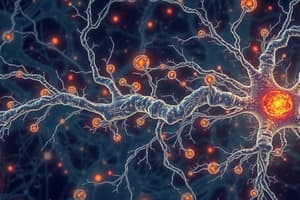Podcast
Questions and Answers
What is the primary function of the cerebrospinal fluid in the CNS?
What is the primary function of the cerebrospinal fluid in the CNS?
- To regulate the body's blood pressure
- To provide metabolic support to the nervous tissue cells
- To act as a shock absorber and protect the brain from mechanical damage (correct)
- To facilitate the transmission of electrical signals between neurons
What is the main reason why the brain needs a continuous supply of glucose and oxygen?
What is the main reason why the brain needs a continuous supply of glucose and oxygen?
- Because it has a low glycogen storage capacity
- Because it has a high energy requirement (correct)
- Because it has a low energy requirement
- Because it has a high glycogen storage capacity
What is the function of the blood-brain barrier?
What is the function of the blood-brain barrier?
- To facilitate the transmission of electrical signals between neurons
- To facilitate the exchange of substances between the blood and extracellular fluid in the CNS
- To regulate the body's blood pressure
- To restrict the exchange of substances between the blood and extracellular fluid in the CNS (correct)
What is the role of cerebrospinal fluid in maintaining the correct composition of the environment surrounding nervous tissue cells?
What is the role of cerebrospinal fluid in maintaining the correct composition of the environment surrounding nervous tissue cells?
What is the mechanism by which action potentials propagate along a neuron?
What is the mechanism by which action potentials propagate along a neuron?
What is the role of the blood-brain barrier in protecting the CNS from pathogens?
What is the role of the blood-brain barrier in protecting the CNS from pathogens?
What is the function of the components of the immune system present in the cerebrospinal fluid?
What is the function of the components of the immune system present in the cerebrospinal fluid?
What is the significance of the cerebrospinal fluid in reducing the weight of the brain?
What is the significance of the cerebrospinal fluid in reducing the weight of the brain?
What is the role of the cerebrospinal fluid in maintaining homeostasis in the CNS?
What is the role of the cerebrospinal fluid in maintaining homeostasis in the CNS?
What is the primary function of the metabolic function of the cerebrospinal fluid?
What is the primary function of the metabolic function of the cerebrospinal fluid?
Flashcards are hidden until you start studying
Study Notes
Neurotransmission and Synapses
- Ca2+ induce reactions allow vesicles to fuse with the plasma membrane, liberating contents into the synaptic cleft by exocytosis.
Excitatory and Inhibitory Chemical Synapses
- Activated receptors on the postsynaptic membrane open Na+ channels, resulting in depolarization and an excitatory postsynaptic potential (EPSP).
- Acetylcholine (ACh) is an excitatory neurotransmitter involved in synaptic transmission at neuromuscular junctions.
- Activated receptors on the postsynaptic membrane open Cl- channels, resulting in hyperpolarization and an inhibitory postsynaptic potential (IPSP).
- Inhibitory synaptic transmission uses a neurotransmitter called GABA, which interacts with GABA receptors, making it harder for a neuron to generate an action potential.
Synaptic Effectiveness and Activation
- The effectiveness of a synapse can be influenced by both presynaptic and postsynaptic mechanisms.
- The amount of neurotransmitter released affects the amplitude of the EPSP or IPSP in the postsynaptic cell.
Neurotransmitters and Neuromodulators
- Neurotransmitters are chemical messengers that transmit signals from nerve cells to target cells.
- A neuron conducting signals toward a synapse is called a presynaptic neuron, while a neuron conducting signals away from a synapse is a postsynaptic neuron.
Neural Growth and Regeneration
- The development of neurons is guided by neurotropic (neuro growth) factors.
- Neurons outside the CNS can repair themselves, but neurons within the CNS cannot.
- Neurotrophic factors allow a neuron to develop and maintain connections with its neighbors.
Synapses
- A synapse is a junction between two neurons, influencing the electrical activity in the postsynaptic neuron, either excitatory or inhibitory.
- Electric synapses have gap junctions, allowing action potentials to flow directly across the junction.
- Chemical synapses use neurotransmitters to transmit signals across the synaptic cleft.
Functional Anatomy of Synapses
- Axon terminals of presynaptic neurons end in a swelling, separated from the postsynaptic neuron by the synaptic cleft.
- Neurotransmitters are stored in membrane-bound synaptic vesicles and released into the synaptic cleft when an action potential depolarizes the axon terminal.
Blood-Brain Barrier and Cerebrospinal Fluid (CSF)
- The brain is dependent on a continuous supply of glucose and oxygen via blood and has little stored glycogen.
- The blood-brain barrier restricts the exchange of substances between the blood and extracellular fluid in the CNS.
- CSF provides mechanical and supportive, protective, and metabolic functions, maintaining the correct composition of the environment surrounding nervous tissue cells.
Studying That Suits You
Use AI to generate personalized quizzes and flashcards to suit your learning preferences.




